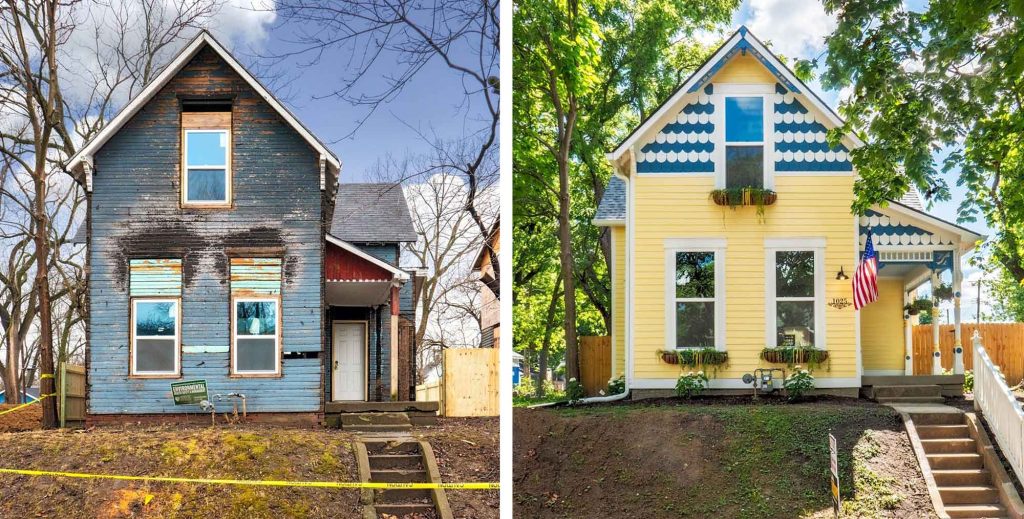Flipping houses can be a lucrative venture, but it also comes with its fair share of financial burdens. If you’re considering getting a mortgage loan to flip a house, there are a few things you need to know. In this article, we’ll explore the costs associated with flipping a house, the types of loans available, and some tips to help you secure financing for your project.
Understanding the Costs of Flipping a House
Before diving into the details of getting a mortgage loan, it’s important to understand the costs involved in flipping a house. Flipping a house requires more funds than purchasing a home to live in because you need to cover not only the purchase price but also the costs of renovations, utilities, property taxes, and homeowners’ insurance. Additionally, depending on your federal income tax bracket, you may face short-term capital gains tax rates when you sell the flipped property within a year.
The reason flipping a house is considered riskier by lenders is that it involves a higher level of uncertainty and potential financial loss. As a result, finding a lender who is willing to work with you, especially if you’re inexperienced, can be challenging. Lenders may charge higher interest rates and fees or require you to have a successful track record of flipping properties for profit.
Types of Loans for House Flipping
When it comes to financing your house flipping project, there are several types of loans you can consider. Each has its own advantages and disadvantages, so it’s important to understand which option best suits your needs.
1. Hard Money Loans
Hard money loans are a popular choice for house flippers because they are easier to qualify for compared to traditional mortgages. These loans are typically based on the value of the property rather than your credit score. While lenders may consider your debt-to-income ratio, they often overlook credit scores. Another advantage of hard money loans is the faster approval process due to less stringent underwriting. However, it’s important to note that interest rates and origination fees for hard money loans are usually higher than those for traditional mortgages.
2. Home Equity Line of Credit (HELOC)
A home equity line of credit (HELOC) allows you to use your existing property as collateral to finance your house flipping project. With a HELOC, you have a revolving line of credit based on the equity of your current property. There are two phases: the draw period and the repayment period. During the draw period, you only pay interest on the amount you use from the line of credit. Once the repayment period begins, you need to pay both the principal and interest, and you can no longer access the line of credit.
3. Cash-Out Refinance
If you already own another property with equity, you can consider a cash-out refinance to fund your house flipping venture. With a cash-out refinance, you borrow against the equity in your existing property and use that money to invest in the property you’re flipping. This option is often more affordable compared to other financing options since it is based on an already finished primary residence. Lenders view cash-out refinances as less risky because the property is already in a livable condition.
How to Secure a Mortgage Loan for Flipping a House
Now that you understand the costs involved and the types of loans available, let’s explore some tips to help you secure a mortgage loan for flipping a house.
Prepare Detailed Blueprints
Before approaching lenders, it’s crucial to have detailed blueprints and estimates from contractors. Lenders will want to see your plans and have a clear understanding of the costs involved in renovations and repairs. Having a well-thought-out plan will not only impress lenders but also give you a realistic view of the financial requirements of your project.
Understand the Market
To avoid surprises, it’s essential to have a good understanding of the market you’re operating in. Appraisers determine the value of your property based on similar properties in the area, so analyzing recent sales and understanding market trends can help you estimate the potential value of your flipped property.
Know Your Loan-to-Value Ratio (LTV)
The loan-to-value ratio (LTV) is an important factor in determining your mortgage rate and the financing available for purchasing the property. This ratio compares the overall value of the home to the amount of the loan. Understanding your LTV can help you assess the potential loan options and their associated costs.
Build a Strong Credit History
While hard money loans may be more lenient when it comes to credit scores, having a strong credit history can still benefit you when seeking financing. Building a good credit history demonstrates your ability to manage financial responsibilities and may increase your chances of securing favorable loan terms.
Research and Compare Lenders
Not all lenders are created equal, especially when it comes to financing house flipping projects. Take the time to research and compare lenders, considering their experience with house flipping loans, interest rates, fees, and repayment terms. Additionally, seek recommendations from other house flippers or real estate professionals who have experience in this area.
Prepare a Solid Business Plan
Lenders will want to see a well-prepared business plan that outlines your strategy for flipping the house and the potential for profit. Include details such as the property’s purchase price, renovation costs, expected selling price, and your estimated timeline. A solid business plan demonstrates your commitment and understanding of the project, increasing your chances of securing financing.
Maintain a Cash Reserve
Flipping a house can be unpredictable, and unexpected costs may arise during the renovation process. It’s crucial to maintain a cash reserve to cover these additional expenses. Aim to have a reserve of at least 20-30% of the total project cost to ensure you can handle any surprises without derailing your project.
Seek Expert Advice
If you’re new to house flipping or unfamiliar with the financing process, seeking advice from experts can be invaluable. Consult with real estate professionals, mortgage brokers, or experienced house flippers who can provide guidance and insight into the best strategies for securing a mortgage loan for your project.
Stay Organized and Documented
Keeping thorough records of your project’s financials, including costs, receipts, and invoices, will not only help you stay organized but also provide lenders with the necessary documentation to support your loan application. Demonstrating financial responsibility and attention to detail will enhance your credibility and increase your chances of obtaining financing.
Be Prepared for Challenges
Obtaining a mortgage loan to flip a house can be a challenging process, especially for first-time flippers. It’s important to be prepared for potential obstacles and setbacks along the way. Stay persistent, remain flexible, and be open to exploring multiple financing options until you find the right fit for your project.
Securing a mortgage loan to flip a house involves understanding the costs, exploring different loan options, and following key tips to increase your chances of success. By preparing detailed plans, understanding the market, and building a strong credit history, you can position yourself for favorable financing terms. Remember to stay organized, seek expert advice, and be prepared for challenges as you embark on your house flipping journey. With the right strategy and financing in place, you can turn a profit and achieve success in the competitive world of house flipping.
Contact Dan (954-336-1922) for a free consultation!
—
 About Dan Campanella – Mortgage Specialist
About Dan Campanella – Mortgage Specialist
Dan provides clients with years of proven experience and an abundance of financing options for their mortgages. His common sense approach and devotion to customer service is what sets him apart in the highly competitive mortgage industry. Dan prides himself on consistently delivering “referable services” to his clients, referral sources, and partners.


